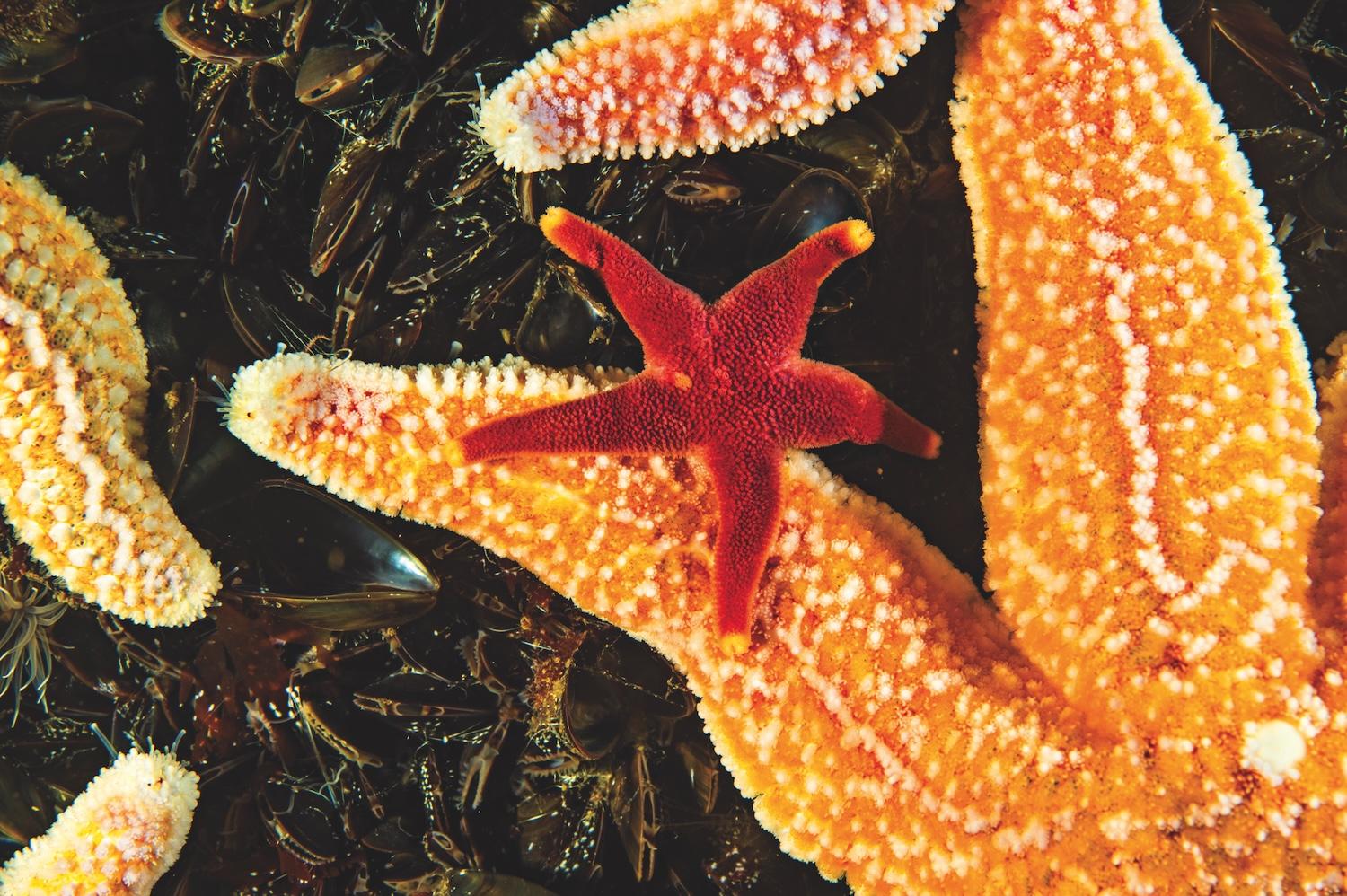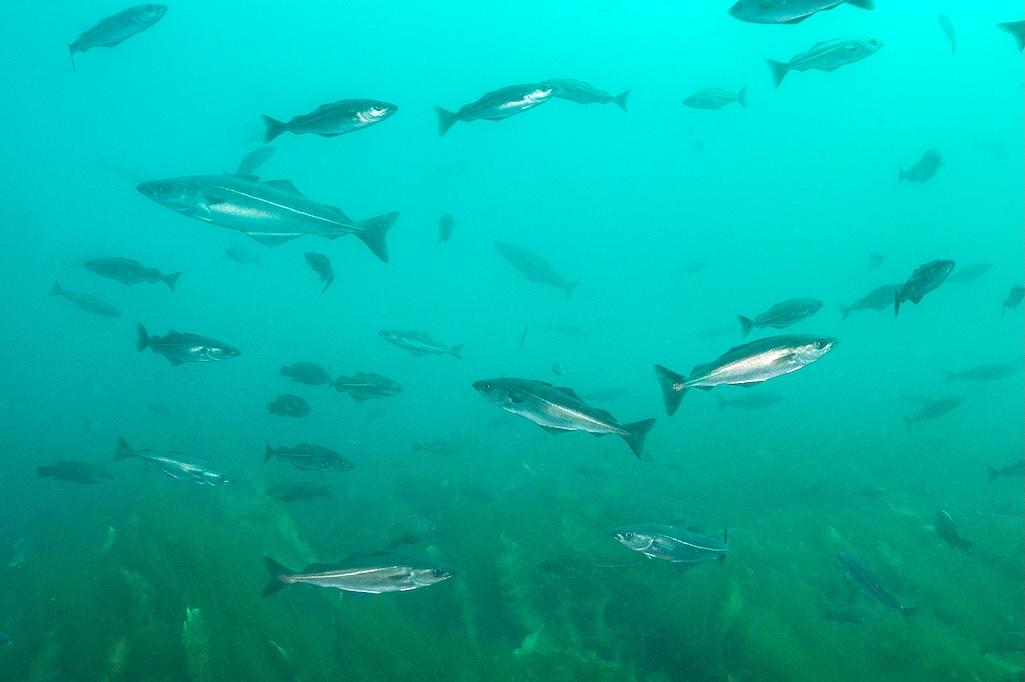Editor's note: There are places in the world that are truly unique and in need of better protection, whether that's within the National Park System or some other federal agency. Cashes Ledge is one of them.
An undersea wonderland some 80 miles off the New England coast bursts with a biodiversity so bountiful that it’s dubbed the Yellowstone of the Atlantic — replete with endangered whales, colorful sea anemones, luminous sea squirts, and schools of coveted Atlantic cod, all thriving in the densest and deepest cold-water kelp forest along the Eastern seaboard.
This bountiful area, Cashes Ledge, is a popular scuba diving and whale- and bird-watching destination. Its natural resources so remarkable that the National Oceanic and Atmospheric Administration (NOAA) has recognized its potential to be a protected national marine sanctuary. And importantly, there’s no time to waste, as waters heating up from climate change threaten this ocean ecosystem.
“If there’s one place to protect in the Gulf of Maine, it’s Cashes Ledge,” Jon Witman, a Brown University marine ecologist who has studied the area since 1977, told the Traveler. “Frankly, it’s a no brainer. It’s a spectacular offshore ecosystem that needs (permanent) protection.

Here on Cashes Ledge is densest and deepest cold-water kelp forest along the Eastern seaboard/Brett Seymour, courtesy of the Conservation Law Foundation
The area, Cashes Ledge, has remained pristine despite other areas in Northeast waters suffering from overfishing and other stressors. It can maintain its robust ecosystem if it is protected from potential future activities like mining, and oil, gas and energy development, which are currently permissible in the area, according to the national marine sanctuary nomination from the Conservation Law Foundation (CLF).
“It really reflects what the Gulf of Maine used to look like before all of the extraordinary impacts,” Conservation Law Foundation Vice President for Ocean Conservation Priscilla Brooks in an interview with the Traveler, adding that the organization has sought permanent protections for the area for a decade or more. “That’s why I think it’s such an interesting place.”
While President Obama in 2016 decided against using his authority under The Antiquities Act to establish a national monument around Cashes Ledge, in January NOAA announced that the area with its diverse marine life and seamounts qualified for sanctuary status consideration. That was welcome news to the CLF — which submitted its the national marine sanctuary nomination for the area to NOAA in July. The nomination garnered support from 151 scientists from various universities and institutes, the Houlton Band of Maliseet Indians in Maine, and many conservation groups, whale watching companies, recreational businesses, zoos, aquariums, photojournalists, arts programs and various education, youth service and faith-based organizations.
“We’ve designated Cashes Ledge as one of the most ecologically important areas in the Gulf of Maine,” Brooks said. “By accepting Cashes into the inventory, NOAA recognizes the national significance of this extraordinary place, we are very pleased with that.”
Still, NOAA has not announced that it’s starting the designation process itself, and it’s not clear the project will get a go-ahead from Republican-led Congress and President Donald Trump’s White House.
With Trump now in office, CLF is concerned about “how quickly we’ll be able to establish a designation for Cashes Ledge as a marine sanctuary under the new administration, which, in the past, has not been supportive of the environment in general,” Brooks said. However, she hopes that NOAA and other regulatory bodies will “see the benefits of protecting special places in the oceans and continue to do so.”
Witman added that he was “hopeful this proposal to NOAA will have an impact and slowly steamroll into a greater amount of support.”

The area supports an incredible array of marine life/Brett Seymour, courtesy of the Conservation Law Foundation
Deep Dive Into Diversity
The proposed Cashes Ledge National Marine Sanctuary spans 766 square miles — more than two-thirds the size of Rhode Island — of the ocean. At the heart of it would be a submerged 32-mile-long mountain range that includes Cashes Ledge, Sigsbee Ridge and Parker Ridge seamounts. The proposed area is also home to basins plunging as deep as 725 feet below the ocean’s surface.
Patches of hard, red and pink crustose coralline algae, orange sea stars, and large anemones dot the steep, granite mountain slopes. The terrain is a maze of large boulders and cobbles. A rare species of blue sponge can be found along the mountain flanks, and Atlantic wolffish nestle in the crevices. Endangered North Atlantic right whales; humpback, minke, and fin whales; harbor porpoise; white-sided and bottlenose dolphins; and blue and basking sharks have also been seen in the proposed sanctuary area, according to CLF.
Along the mud and silt floor of the Ammen and Cashes basins dwell northern shrimp, white hake, mud anemones, and tube worms. Sponges and brachiopods attach themselves to cobbles and gravel along bedrock between the slopes to the muddy pits. The widespread mountain pinnacles are studded with patches of kelp, where pollock, clusters of sea anemones and other invertebrates and fish reside.
At the center of Cashes Ledge rises its tallest mountain: the roughly 430-foot-tall Ammen Rock. Its dome-shaped peak is home to the deepest and densest cold-water kelp forest on the East Coast. The forest is described by CLF as an “oasis of unusually high kelp and fish abundance in the Gulf of Maine." The fronds of its kelp can reach as high as 20 feet. Tucked between the blades and strips of kelp reside schools of Atlantic cod — populations of which have been decimated elsewhere throughout the Gulf of Maine due to historic overfishing, both in their traditional gray color and an unusual red variety. In the nomination, CLF describes the forest “one of the “most unique ecological structures” in the Gulf of Maine.
“It’s very unusual to find such a deep and dense kelp forest in the North Atlantic and in its cold waters,” Brooks said. “Everyone I know who has gone diving in this area, particularly in the kelp forest, is stunned.”
Cashes Ledge’s biodiverse ecosystem is supported by an ample food supply. Witman explained that unique current patterns fueled by the area’s topography flow up and down the water column 18 to 20 times per day, spreading kelp detritus and other nutrient sources across the region.
The marine ecologist said that because it has experienced little human disturbance, Cashes Ledge also offers a glimpse into what the rest of the gulf looked like centuries ago. In a Smithsonian article, he described the disparity in robust cod populations at Cashes Ledge versus other sites of similar depth in the gulf where they were once more abundant. “ Cashes Ledge," he noted, "is like a time machine into New England.”
“It’s not a museum, but it’s a unique ecosystem that can show how the Gulf of Maine works with a significantly less degree of interference than with ecosystems along the coast,” said Witman, a supporter of the sanctuary designation who co-authored the Scientists’ Declaration of Support for the Protection of the Cashes Ledge Area section of CLF’s nomination.
To properly protect Cashes Ledge, the federal government should protect it from “extractive and otherwise damaging activities,” such as offshore wind energy development. The group also proposes banning deep sea cables for energy transmission and communication in 25 percent of the proposed sanctuary.
There currently are no plans for laying cables or leases for gas, oil, or offshore development leases or established for any area within the proposed sanctuary, according to CLF.
Still, “I think you can’t predict the kinds of development that are ahead, but we know there is pressure to use more and more of our oceans,” Brooks said. “It’s critically important to protect some of these outstanding areas that have rich biodiversity and are unique.”

There is a dazzling array of color displayed by the marine life at Cashes Ledge/Brian Skerry, courtesy of the Conservation Law Foundation
Warming Up
Yet like many marine ecosystems in the Gulf of Maine — which is warming faster than 97 percent of the world’s ocean surface — Cashes Ledge is threatened by climate change that is altering the sea life. Witman on an expedition with fellow scientists in 2023 found that cod, while still abundant, have decreased in recent years, and short finger kelp is replacing the sugar kelp that forms the forest canopy. He said invasive red algae has also been carpeting more of the forest floor in recent years, covering 6 percent in 2016 to a ballpark estimate of 30 percent today.
“The kelp forest community is shifting gradually,” he said.
Protecting the area’s biodiversity can make Cashes Ledge more resilient to climate change, according to Witman and Brooks.
“Ecosystems with a high abundance and diversity of species have the ability to adapt and recover from stressors,” Brooks said.
Fishing
Commercial fishing, including for groundfish like haddock and cod and for lobster, has occurred in parts of Cashes Ledge for more than 100 years. Regulations mitigate to some extent this activity in the area, but CLF argues that any of them can be overturned without the federal enforcement offered by the marine sanctuary designation.
Sanctuary advocates also want commercial fishing banned in a zone encompassing 25 percent of the proposed sanctuary that includes Ammen Rock and its kelp forest.
The National Marine Fisheries Services manages and regulates commercial fishing in the area along with the Atlantic States Marine Fisheries Commission and various councils, such as the New England Fishery Management Council that oversee groundfish, salmon and other species.
"The New England Fishery Management Council previously worked to establish a year-round groundfish closure area in Cashes Ledge that prohibits all bottom trawls and dredges,” Janice Plante, public affairs officer for the council, wrote in an email to the Traveler. The council has also enforced additional habitat closure areas that prohibit fishing with large nets dragged by boats along the seafloor, as well as other equipment.
In its nomination, CLF maintains that establishing a marine sanctuary for Cashes Ledge would cause “minimal disruption to the commercial fishing industry because much of the proposed sanctuary overlaps with the existing Cashes Ledge Groundfish Closure and Habitat Management Areas.”
So far, neither the New England Fishery Management Council nor the Atlantic States Marine Fisheries Commission have voiced a position on CLF’s sanctuary proposal..

Schools of fish are attracted by the plentiful meals carried by the water columns at Cashes Ledge/Brett Seymour, courtesy of the Conservation Law Foundation
Research Opportunities
CLF hopes that by permanently protecting Cashes Ledge from various development pressures it will broaden opportunities for marine research. Increased visibility for the area could attract research funding and support investigations into the region’s ecosystem dynamics and the impacts of global warming on it, Brooks said.
“It’s an opportunity to understand — study and understand — how the national community in a less perturbed state than in most coastal communities is affected by climate change,” Witman said. “We can make better scientific inferences on how things work on Cashes Ledge.”
Brooks said a national marine sanctuary at Cashes Ledge could include expanded diving opportunities, K-12 education programs, citizen science projects like sampling, webinar film nights to showcase documentaries on the area, and physical and virtual exhibits and maybe even a visitor like in Thunder Bay.
“We’ve designated Cashes Ledge as one of the most ecologically important areas in the Gulf of Maine,” Brooks said. “It’s critically important to protect some of these outstanding areas that have rich biodiversity and are unique.”



 Support Essential Coverage of Essential Places
Support Essential Coverage of Essential Places






